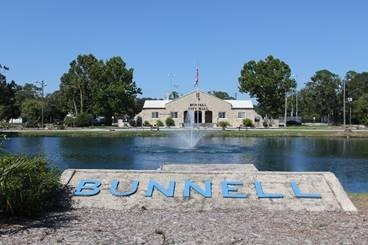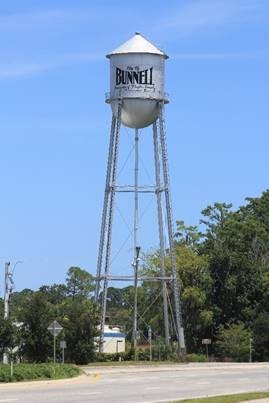
For Immediate Release
Wednesday, March 27, 2019
Contact: Sarah Revell
850.245.6522
[email protected]
Secretary Lee Announces the Designation of Two Bunnell Properties on the National Register of Historic Places
Tallahassee –
Secretary of State Laurel M. Lee announced today that the Bunnell City Hall and Bunnell Water Tower, located in Flagler County, have been listed on the National Park Service’s National Register of Historic Places.
“Bunnell City Hall and Bunnell Water Tower are fantastic additions to the National Register of Historic Places,” said Secretary of State Laurel M. Lee. “These structures reflect the development of the city of Bunnell in the decades after its incorporation as it grew and transformed.”
Bunnell City Hall is historically significant for its role as a civic center from 1937 until the 1990s, and for its association with the Works Progress Administration’s (WPA) make-work programs during the Great Depression. A federal civic works program, the WPA constructed public projects such as roads, bridges, state parks and schools around the nation as part of President Franklin D. Roosevelt’s “New Deal” plan to employ millions of workers. Federal aid provided by the WPA created jobs for the unemployed local labor force which boosted the local economy.

Bunnell City Hall provided a community and recreation center that stimulated Bunnell’s sense of public pride and created accommodations for community activities which energized and promoted community development. After it opened, the center quickly became a focal point for Bunnell’s social life. The building provided meeting space for various social organizations, including the American Legion, the Bunnell Youth Council and the Lions Club.
Bunnell City Hall is an excellent example of WPA rustic-style architecture through its simple design and use of local materials, most notably coquina stone. The hand hewn stone blocks laid in irregular courses highlight the natural materials and workmanship that went into the construction of the building.
In the 1990s, the city of Bunnell relocated its city hall from the Old Bunnell State Bank Building to the civic center, and renamed the building Bunnell City Hall, adding the current Bunnell City Hall sign at that time. City Hall remained in the building until 2006 when the city moved its administrative offices to a modern office building. Bunnell City Hall, currently managed by the city, now functions as a community center that hosts a variety of community events. It serves as a symbol of the community and is featured prominently in the city’s logo.
The Bunnell Water Tower is such a prominent landmark that it was featured on the 2013 City of Bunnell centennial logo. Its design type is commonly referred to as the “tin man.” First introduced in Europe in the 1880s, the curved bottom trestle tower water tanks were first used in the United States in 1891. The elevated trestle tower tanks supported on four legs had cost advantages to towers and standpipes that stood directly on the ground.

Bunnell Water Tower was built in 1926 by Chicago Bridge & Iron Works, which built numerous other water towers (at least seven of which are listed in the National Register across the United States). The tower was part of a new waterworks system for Bunnell that included the water tower, a reservoir building and a pumping station that all went into operation in December 1927.
Construction of the Bunnell Water Tower is a significant part of Bunnell’s history, instrumental to the development and modernization of the area. It replaced a larger wooden storage tank constructed around 1913 that occupied a plot of land at the edge of Bunnell’s business district over a mile from the site of the present waterworks. Today, the city of Bunnell maintains modern ground storage tanks, but the “tin man” stands as a lasting symbol Bunnell’s more than 100 year history.
# # #
About the National Register of Historic Places
The National Register of Historic Places is a list maintained by the National Park Service which includes historical or archaeological properties including buildings, structures, sites, objects, and districts, that are considered worthy of preservation because of their local, statewide and/or national significance. Nominations for properties in Florida are submitted to the National Park Service through the Florida Department of State’s Division of Historical Resources. Florida has over 1,700 listings on the National Register, including 295 historic districts and 175 archaeological sites. There are more than 50,000 sites contributing to the National Register in Florida. For more information, visit flheritage.com/preservation/national-register. For more information about the National Register of Historic Places program administered by the National Park Service, visit nps.gov/nr.
About the Florida Department of State’s Bureau of Historic Preservation The Bureau of Historic Preservation (BHP) conducts historic preservation programs aimed at identifying, evaluating, preserving and interpreting the historic and cultural resources of the state. The Bureau manages the Florida Main Street Program, and under federal and state laws, oversees the National Register of Historic Places program for Florida, maintains an inventory of the state's historical resources in the Florida Master Site File, assists applicants in federal tax benefit and local government ad valorem tax relief programs for historic buildings, and reviews the impact that development projects may have on significant historic resources. For more information, visit flheritage.com/preservation.
